Sporting
In Full Pursuit
Foxhunting with Ben Hardaway and his legendary crossbred hounds
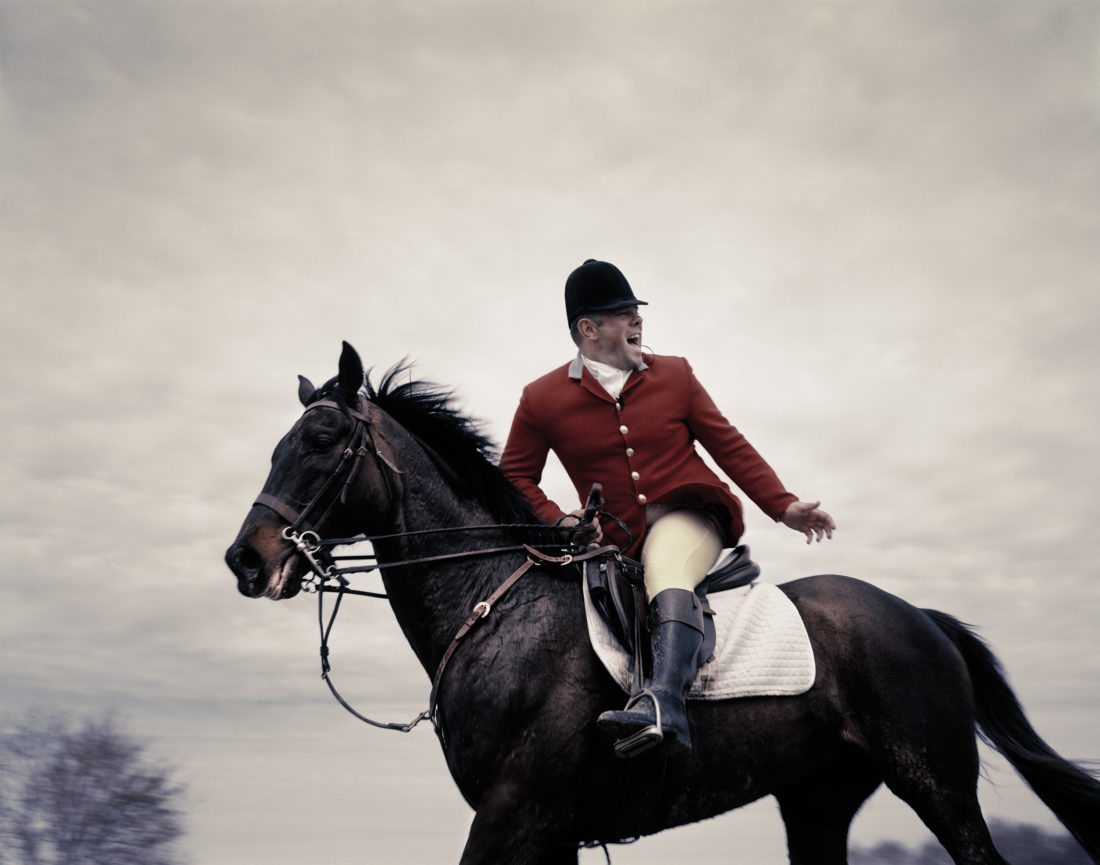
Photo: Andy Anderson
Well before dawn, Ben Hardaway sips coffee in a dim kitchen, already dressed for the day’s hunt. Even in the poor light of early morning, his passion for foxhunting is evident. This longtime master of foxhounds stands impatiently in dun-colored tights, starched white shirt, scarlet “pinque” hunt coat with artillery blue collar, and knotted white stock tie that can double as a tourniquet or sling. This ensemble would appear to require a small team of assistants to quickly pull together at such an early hour, but after several decades of practice, the eighty-eight-year-old gentleman is up and dressed before everyone else in the house.
Mason Lampton, his son-in-law and joint master at today’s hunt, mans the stove in matching duds, and doles out a final round of bacon and sausage from a hot skillet. Hardaway moves stiffly in knee-high black leather riding boots as he reaches for a last piece.
“Getting old ain’t for sissies,” he mutters. “If I’d have known I was going to live this long, I’d have taken better care of myself.”
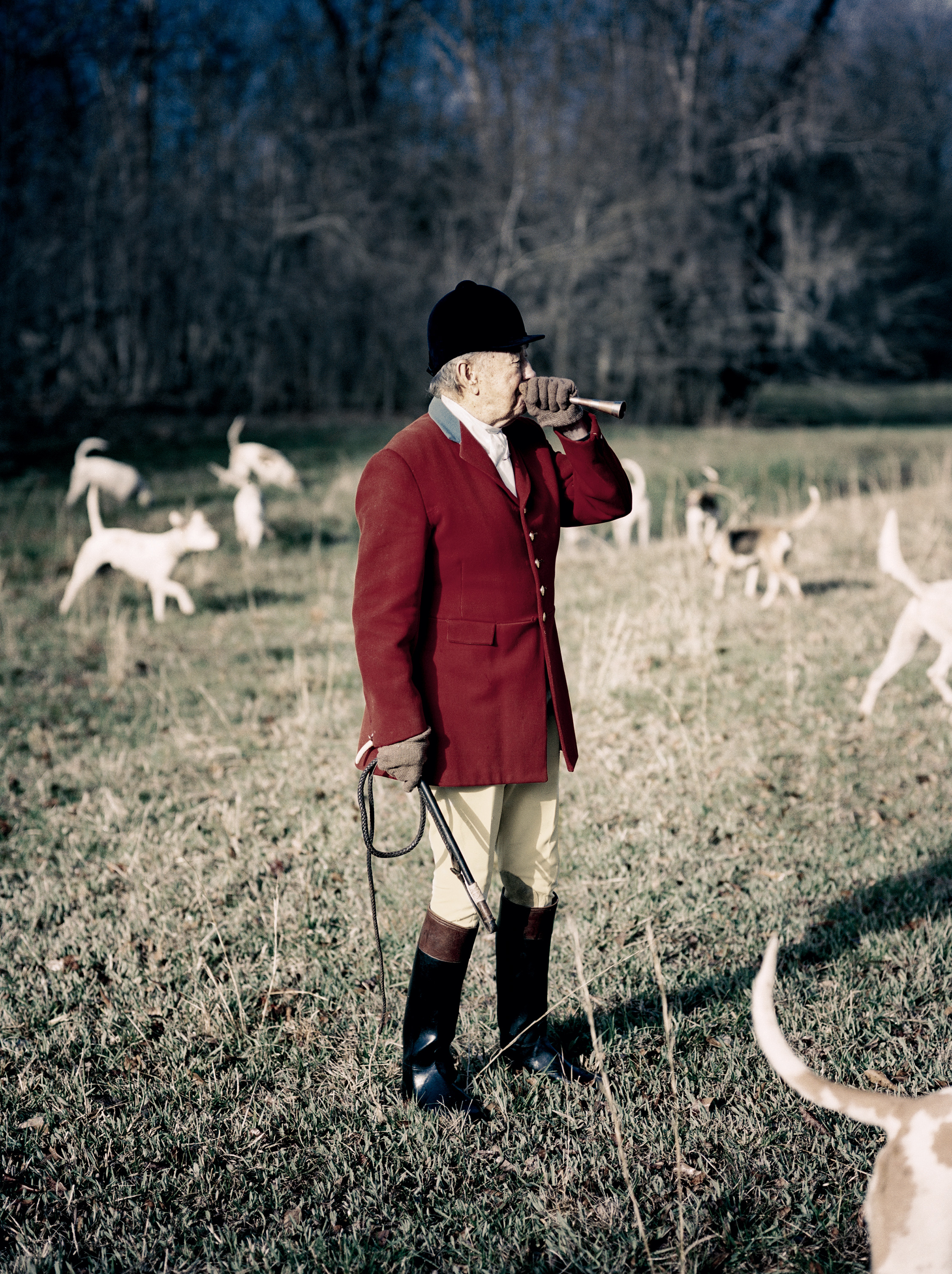
Photo: Andy Anderson
Hardaway rounds up his famous foxhounds.
Lampton chuckles at Hardaway’s gruff wit and soon observes it’s time to meet the hounds. The two men have hunted together since 1970, and they have served as joint masters of the Midland Fox Hounds for the past ten years. They lead the way out the front door, a blaze of scarlet in the late-winter landscape. As we drive the quarter mile to the hunt’s designated meeting point, I attempt to quickly get my bearings. We are on Lampton’s private farm, tucked into the rolling plains of Alabama, about an hour east of Montgomery near the hamlet of Fitzpatrick. The sky is overcast and the temperature a brisk fifty degrees with a good dose of humidity, conditions I am told are desirable for a hunt. Moisture in the air is critical, according to Hardaway, as it allows for “a breast-high rising scent” that his hounds can chase all day. As we approach the throng of horses and hound trailers, the anticipation is palpable. Mine can be more easily defined — I have never seen a foxhunt, and am still naively hoping they’ll let me ride a mount in street clothes. But the source of Ben Hardaway’s excitement is more elusive. What element of this sport is so intoxicating that, after seventy-six years, it could still drag a man from his bed before dawn? Is it the exhilaration of the pursuit? Simple force of habit? Or just the chance to see good friends in this otherwise unmarked corner of Alabama? Hardaway provides a clue, however obvious, when prodded from the backseat.
“It’s all about the dogs.”
By this he means his dogs, the Hardaway crossbred hounds, which he has spent the past seven decades perfecting. Clearly, this is his driving passion, and it is the animal that most vocally defines a sport dedicated to pursuit of the sly and stealthy fox. In Hardaway’s well-written autobiography, Never Outfoxed, he describes the moment that would change his life when, at age eleven, on a night hunt outside Columbus, Georgia, he first encountered foxhounds.

Photo: Andy Anderson
Ben Hardaway in full dress, delighted by the sounds of the hunt.
“On one particular and unforgettable night, we were hunting up along Heiferhorn Creek,” he writes. “Our hounds were cold-trailing a coon when I heard a strange sound drifting down through the valley. I stopped and whispered to Mr. Hett, ‘What in the world is that?’ Mr. Hett told me that it was Mr. Eddie Robinson’s foxhounds running a red fox. I stood, glued to the ground, listening to the beautiful sound of those foxhounds. I was awestruck to the very core of my being. It was then that I knew that foxhounds were what I wanted. The feeling I had that night has never left me and it doesn’t look like it ever will.”
Young Hardaway traded in his coon and possum dogs for foxhounds that very next day, and since that auspicious moment he has worked to build a pack of hounds that have gained a worldwide reputation for their relentless drive, excellent nose, and “biddability” — which Hardaway defines as the willingness of notoriously stubborn hounds to abide by the wishes of their master during the hunt. But it is the fourth quality by which a hound is typically judged — his cry — that I most look forward to experiencing. Given that I am certain to be a bystander in this hunt, the rising notes of the hounds’ cry as they course through the woods in hot pursuit of a fox is the quality I can most easily appreciate from a distance. This backwoods symphony is the music that has haunted Ben Hardaway since he was a child.
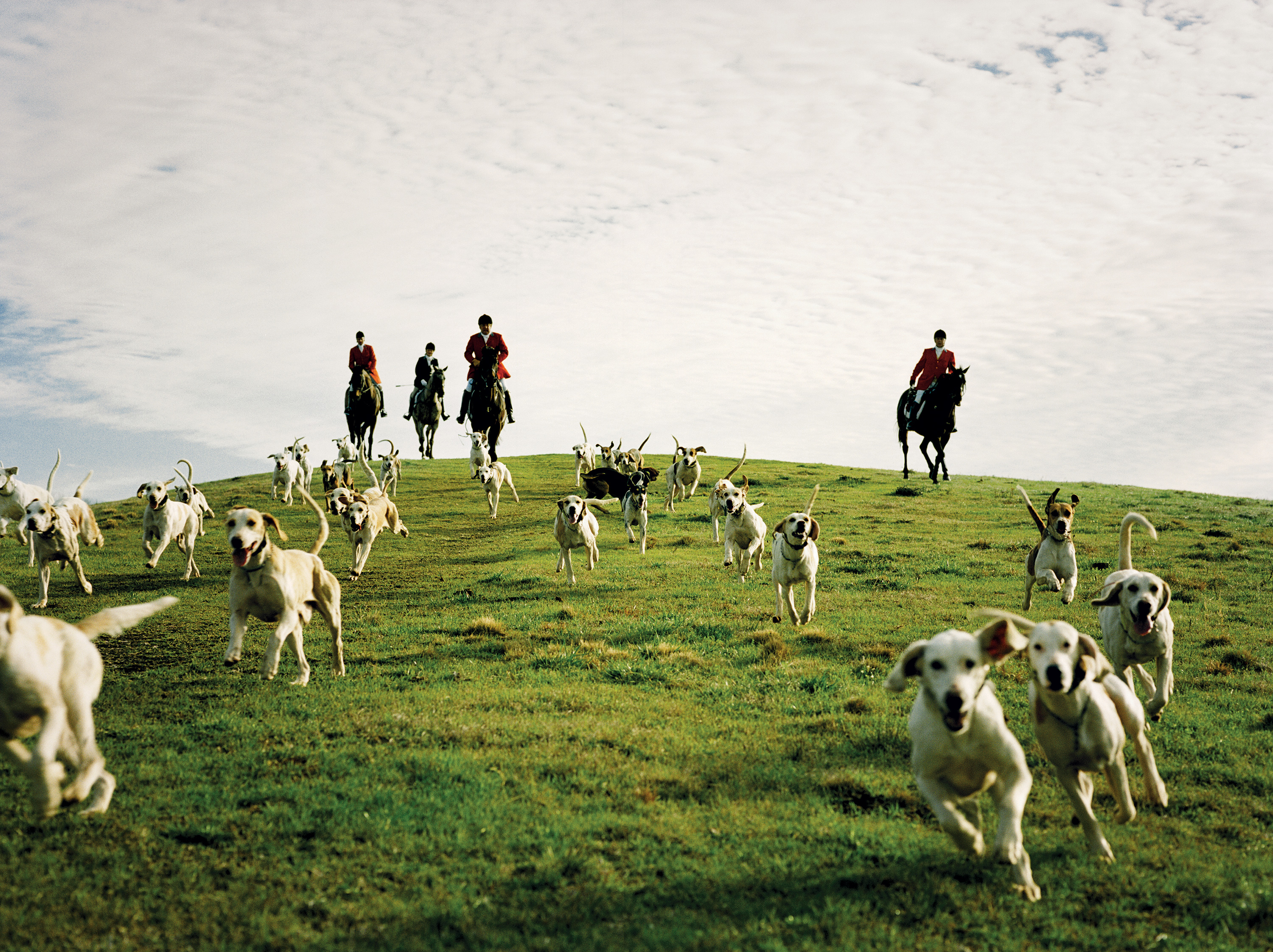
Photo: Andy Anderson
The Hardaway crossbred hounds in full pursuit of the red fox
At the rendezvous, I walk past the crowd of scarlet-clad huntsmen and staff to the thirty-five-foot-long trailer where puppy walker Julie McKee is feeding sausage-stuffed yeast rolls through a steel mesh grill to Hardaway’s foxhounds. Tradition holds that for good luck hounds should be hunted in odd numbers, and the Midland Fox Hounds, the private hunt club that Hardaway founded in 1951, hunts fifty-one. As the voracious dogs leap on top of each other to get at the treats, the puppy walker gives me a roll and a little friendly advice.
“Watch out. They’ll take your arm off.”
Then, with a whip handle made from a deer’s antler, she points out the traits of the different breeds composing the Hardaway crossbred hound. Some have the black and blue ticking and long ears of the Penn-Marydel, others the coarse merle coats and pale blue eyes of the July, and others the big black and white spots and short ears of the English Fell hound. As a prolific breeder of foxhounds, Hardaway is well known for having tossed aside the conventions of most English and American breeding programs, which emphasized a uniformity of looks at the expense of stamina or disposition. He began with the bedrock bloodline of Georgia foxhunting, the hard-running July hound, and crossed it with other strains of hounds that impressed him from Ireland, England, and the mid-Atlantic states, until he produced a dog that could hunt with the fearless tenacity he expected and the biddability required — appearances be damned. Hardaway struck upon an unlikely ratio for breeding success: five-eighths Fell hound, one-quarter July, and one-eighth Penn-Marydel. Add in the occasional outcross of another breed in the constant tweaking of perfection, and I can understand why this is such a motley-looking crew. The one constant in this crowd is that all the dogs weigh around ninety-five pounds and they can’t wait to tackle a fox.
He pauses for a moment, and gets a distinctly fox-like twinkle in his eye.
“The English called them possum dogs, but they could take a six-foot fence like a Thoroughbred horse,” Hardaway remarks with satisfaction.
At the signal, the trailer gates are opened and the hounds spill out onto the dirt track, fanning out across the pasture to curiously sniff the air. The huntsmen mount their horses, and with the blare of his horn Lampton gathers the hounds. I join Hardaway and his personal driver, Beverly, in a Jeep Grand Cherokee known as the White Stallion to follow the hunt. We barrel across rolling pastures and down winding dirt tracks through the thick stands of hardwoods, trying to keep pace with the pack. With the Jeep’s customized steel-plated underbody, Beverly doesn’t hesitate at creeks or deep ditches, but bounces right through as Hardaway does his best to explain the dynamics of the hound pack.
“They hunt individually to an extent, but all know where each other is. Once one starts speaking, they’re gone quick. That’s that old July blood.”
Soon I see it in action. The dogs cast the line of a scent about an hour old and peel away from the horses in a clamor. A pale July bitch is in the lead, and when she speaks the other dogs answer her cry. The radio crackles as Hardaway barks suggestions into the microphone about the best points to intercept the pack as it disappears from view. Foxhunting requires a good bit of tactical skill to anticipate the direction of pursuit as well as an ability to translate the cacophony of howls and yips into something resembling a progress report. Hardaway honed this skill during his early years as a night hunter, which required him to visualize the location of the dogs and understand the language of the chase. He knows every dog here by its cry. Judging from the sudden crescendo of howls, Hardaway thinks the dogs have caught the scent of a coyote.
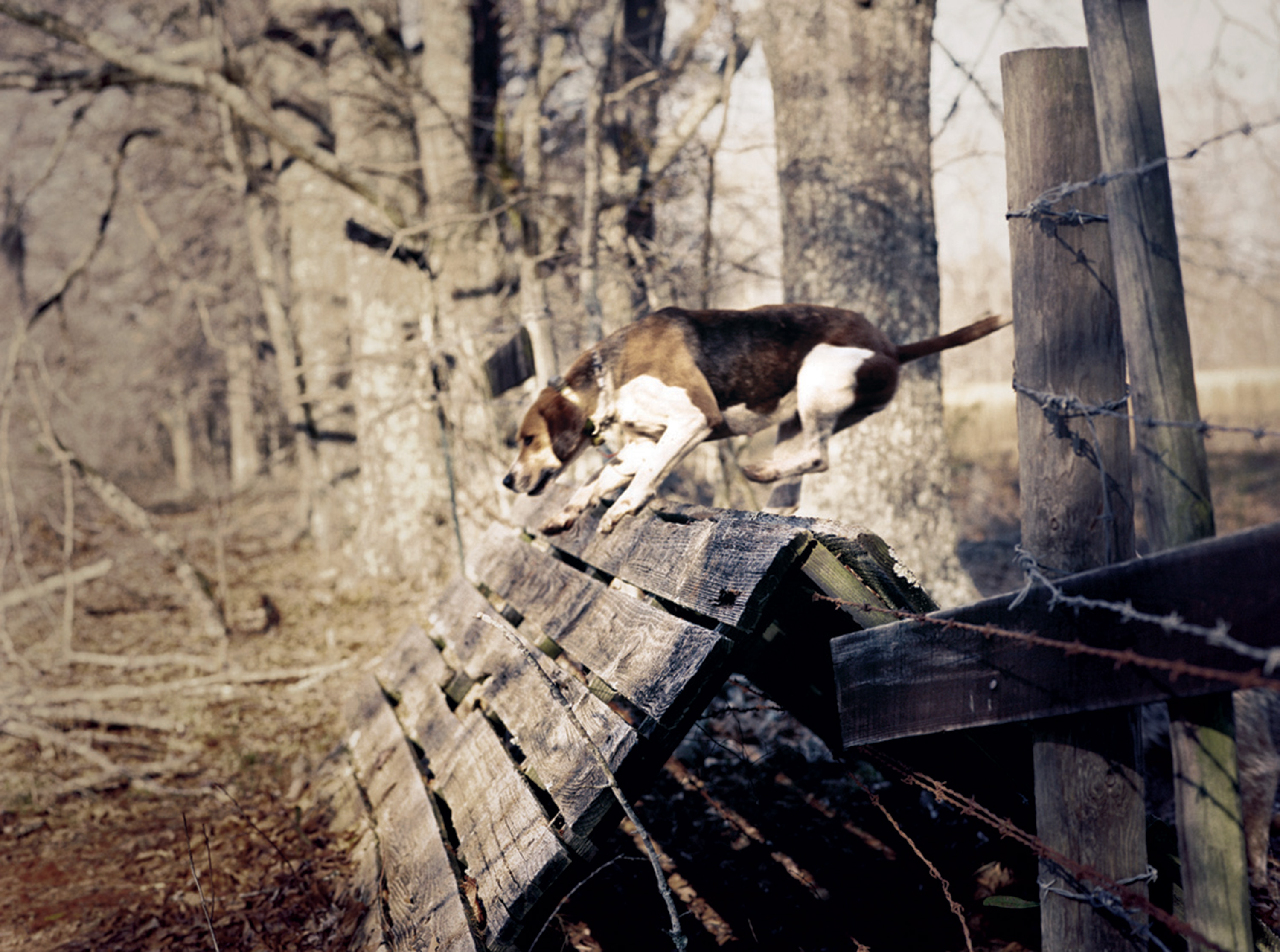
Photo: Andy Anderson
English-type crossbred
“You can tell the difference between dogs running coyote and fox. Coyote must smell ten times stronger than a fox.”
I learn that coyotes have been gradually displacing red foxes from their traditional territories throughout the Southeast, but foxhunters have adapted accordingly. Now foxhunters don’t strictly hunt fox. Coyotes, however, provide a very different kind of sport. A fox circles between a series of dens in a more tightly concentrated territory, typically staying within the same five square miles. Coyotes have a wider territory and, when pursued, will run right out of it. On a recent coyote hunt, Hardaway’s men rode sixteen miles in a straight line in little more than an hour, which is the equivalent of running the Kentucky Derby through a national forest. Nobody knows exactly where this coyote hunt might lead, but we brace ourselves as Beverly guns the Jeep around a few corners and down a long dirt road. After a couple miles with no sight of the hounds, we stop and wait.
The radio occasionally crackles with garbled voices. We stare the length of the dirt track, waiting for the torrent of hounds to cross, but five minutes go by and there’s no sign of a canine. Hardaway walks to the edge of a vacant field, staring intently into the distance as he strains with every fiber to decipher the barks and yelps filtering through the hardwoods. He comes back with his answer.
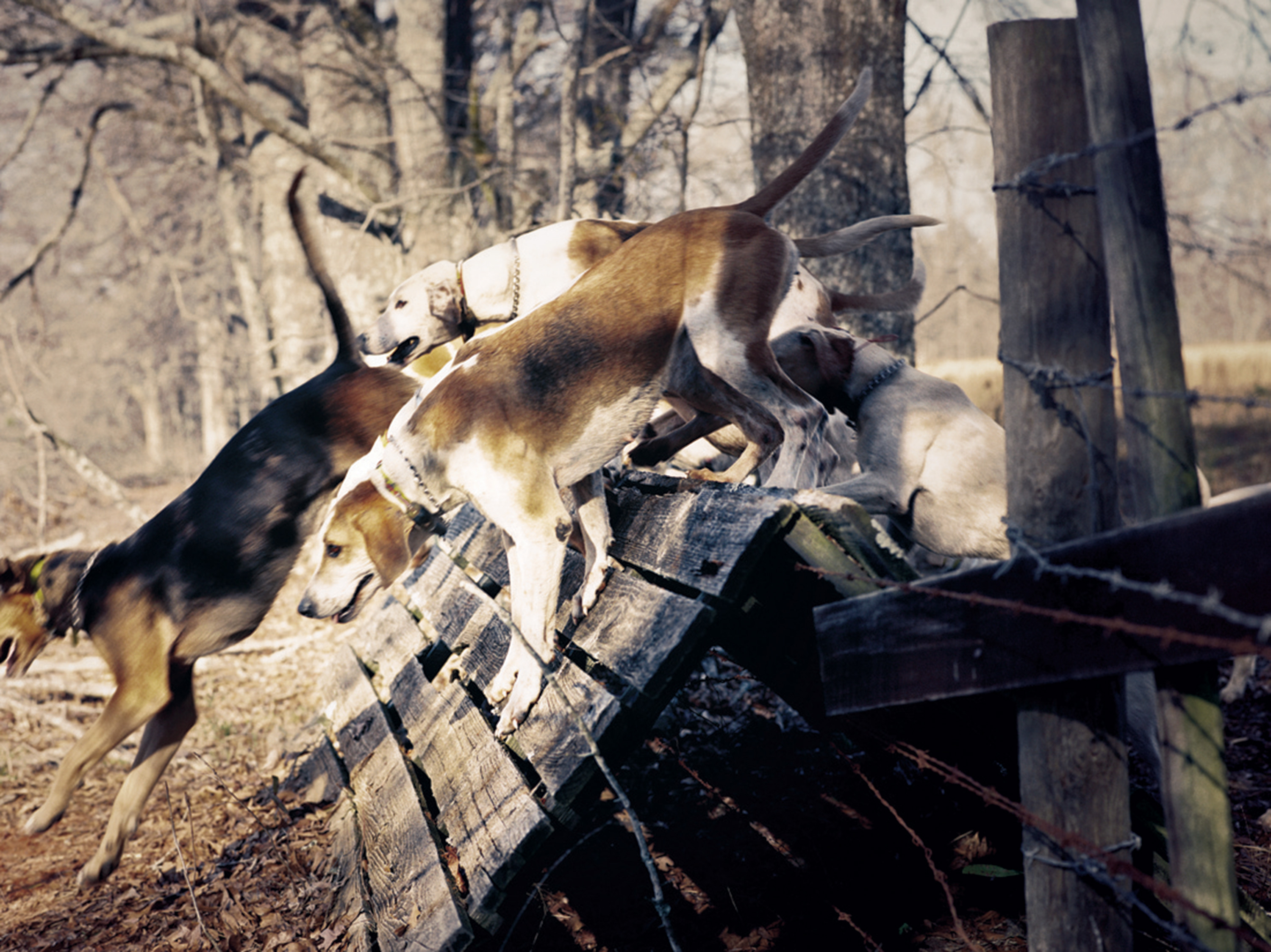
Photo: Andy Anderson
A July, a July/Fell cross bred, and a Hardaway crossbred
“The hounds have checked,” he says — meaning they’ve lost the trail of the coyote. The huntsmen are able to reorganize via radio and gather up the pack to cast another line. We start again, and soon we hear from Lampton that they’ve come across coyote prints by a horse jump and the hounds are going wild. We pull into view in time for Hardaway to point out a few promising hounds as they race past.
“Luck is a strike dog, which is the one that finds the scent when others can’t. Whiskey leads with his voice. Panzer has speed and drive, and he leads the pack on the line and changes direction with the quarry. Kite won a beauty contest in Virginia. She’s got low notes.”
I catch a brief snatch of her sonata before the hounds check again. Judging from Hardaway’s frown, the day’s symphonic performance has not reached the accustomed level of intensity. After a few more dry runs through the woods, it’s agreed that the morning’s lines have been played out, and the hunt heads back to the barn. We are greeted by a midday hunt breakfast of Wal-Mart fried chicken, sliced ham, and casseroles set out across folding tables. While the guests fill their plates, Mason Lampton runs down the list of hounds, making sure all are accounted for. Luck, Lawyer, Lacy, and Lusty. Whiskey, Whalebone, Flasher, and Fleet. Though the hounds were named from a poetic dictionary, Lampton and Hardaway know each of the fifty-one dogs by sight, and they all get a treat from the joint masters of foxhounds before being loaded back into the trailers for an afternoon nap. I can’t help wishing I could take one myself, but we’ve got another hunt tomorrow in Midland, Georgia, the home of Hardaway’s hounds, which is almost two hours and a time zone away.
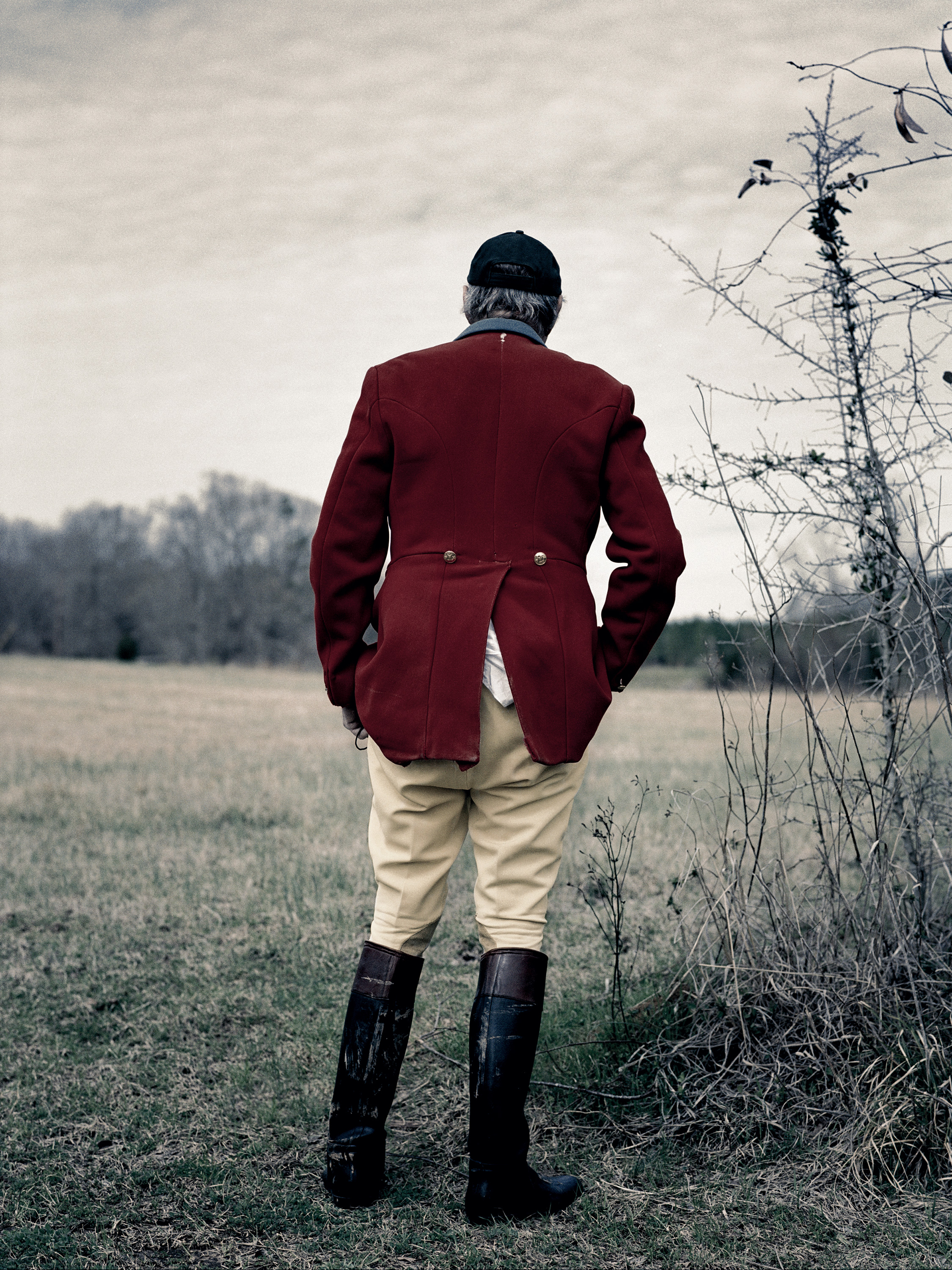
Photo: Andy Anderson
Hardaway deciphers the distant cry of the hounds.
That afternoon, we head east from Fitzpatrick towards the Georgia state line, and after navigating almost eighty miles of two-lane highways and farm roads, I am driving through Columbus on my way to Ben Hardaway’s family compound, just outside the city. Purchased by the family in 1929, the impressive sixty-square-mile tract of steep hills and pastures is the location of Hardaway’s breeding operation, and the hunting grounds of the Midland Fox Hounds. Hardaway leads me back to his study, where we are surrounded by the evidence of a storied career: mounted trophies, framed photos with old friends and favorite dogs, and an engraved silver horn presented to him by the Masters of Foxhounds Association of England “in recognition for outstanding contributions to hound breeding.” This award, from a group that had once resisted accepting his “possum dogs” as equals at the British trials, was one of his biggest thrills. But Hardaway readily acknowledges that his devotion to foxhunting, and the attendant desire to breed the perfect hound, came with a price. He subsidized the nascent breeding operation while off at college and then World War II, and once home he continued to support it with almost single-minded focus through his sixty-two-year marriage while raising four children.
“At times it was tough on my money and my wife. I’d be gone all week bidding [construction] jobs or building them. She’d get mad at me, saying, ‘When you come home you don’t check to see if your children are alive — you go check on your puppies.’” He pauses for a moment, and gets a distinctly fox-like twinkle in his eye. “But I don’t blame her. I didn’t give a damn what it took, I was going to hunt.”

Photo: Andy Anderson
Mary Lu and Mason Lampton, fourth and fifth from left, with guests at the Fitzpatrick, Alabama hunt.
The sport is fortunate that his wife allowed him to pour the time and resources into foxhunting that he did. Frank Bonsal, third generation master of the Green Spring Valley Hounds, outside Baltimore, Maryland, puts it simply:
“Ben Hardaway has done more for foxhunting than anyone in the United States.”
When asked about Hardaway’s influence on the other side of the pond, Alastair Jackson, director of the Masters of Foxhounds Association of England, eliminates any remaining doubt.
“Ben Hardaway has been recognized by masters of hounds and hound breeders in the U.K. for over forty years as having made a significant contribution to hound breeding on both sides of the Atlantic,” he says. “American foxhound blood, through Hardaway’s breeding, can now be found in many English packs, and Hardaway is held in high regard by very many U.K. foxhunters.” The British sound pretty excited to be hunting with possum dogs.
The next morning, up the hill from the house at the Midland kennel, I catch up with Midland Fox Hounds first whip John Eaton as he prepares the hounds for the Sunday afternoon hunt. He had worked the Fitzpatrick hunt the day before, and this hale and hearty young Englishman from Somerset is unusually frank in his assessment of the impact of Hardaway’s breeding program on British foxhunting.
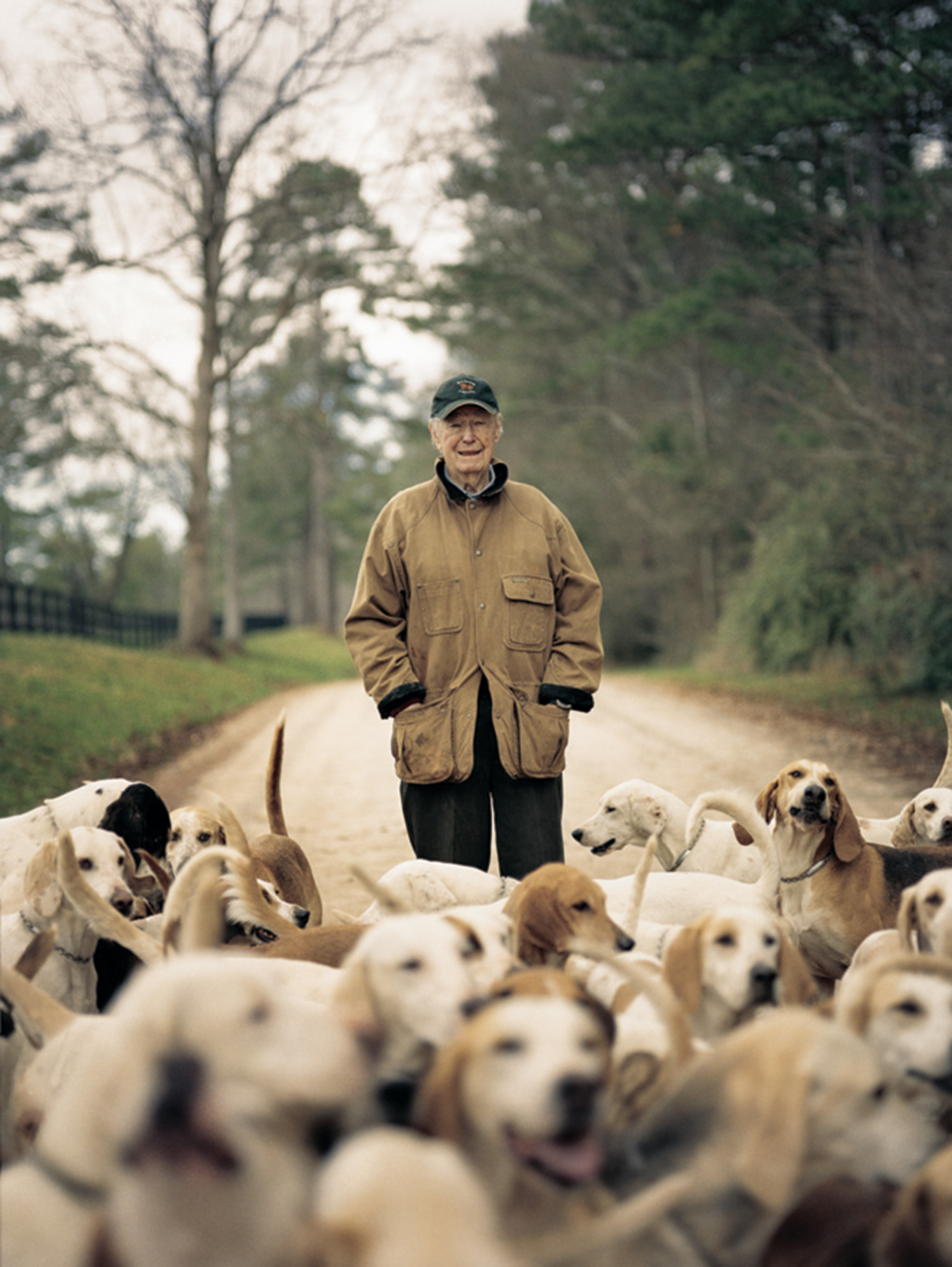
Photo: Andy Anderson
Hardaway takes the pack for an early morning walk around Midland.
“I’m from a real redneck part of England, but even I can tell you that everybody knows Mr. Hardaway. His bloodlines are in almost all of the packs in England, Ireland, and France. You don’t have to go that far back to find the Midland.” He adds, “He’s also got the money to back up his word.”
In the past ten years, Mason Lampton and the hunt club’s private membership have taken over Hardaway’s responsibility for solely underwriting the breeding operation, but the scope of their mission is no less ambitious. The Midland kennel, which supports a pack of two hundred Hardaway hounds, runs through a thousand pounds of dog food a week and a ton of hamburger meat a month. The overall cost of the Midland Fox Hounds breeding operation — with its kennel, staff, equipment, and travel to hunts across the East Coast — runs over a half million dollars a year. But their efforts have not gone unrewarded. The Hardaway hound won five out of eleven performance trials during the 2007 North American Masters of Foxhounds Centennial Celebration.
I follow Eaton from the Midland kennel to the hunt about ten miles away towards Warm Springs. The hounds instantly know where they are, and they yelp and howl in the trailers as the whips struggle to unlock the new farm gate. The day is bright, with little humidity, and there’s a strong breeze out of the east — some of the least desirable conditions for a foxhunt, according to Hardaway. While it’s not good hunting weather, the dogs don’t seem to care, and neither do the assembled horsemen. Before he mounts, I ask Eaton what he thinks of the morning’s prospects.
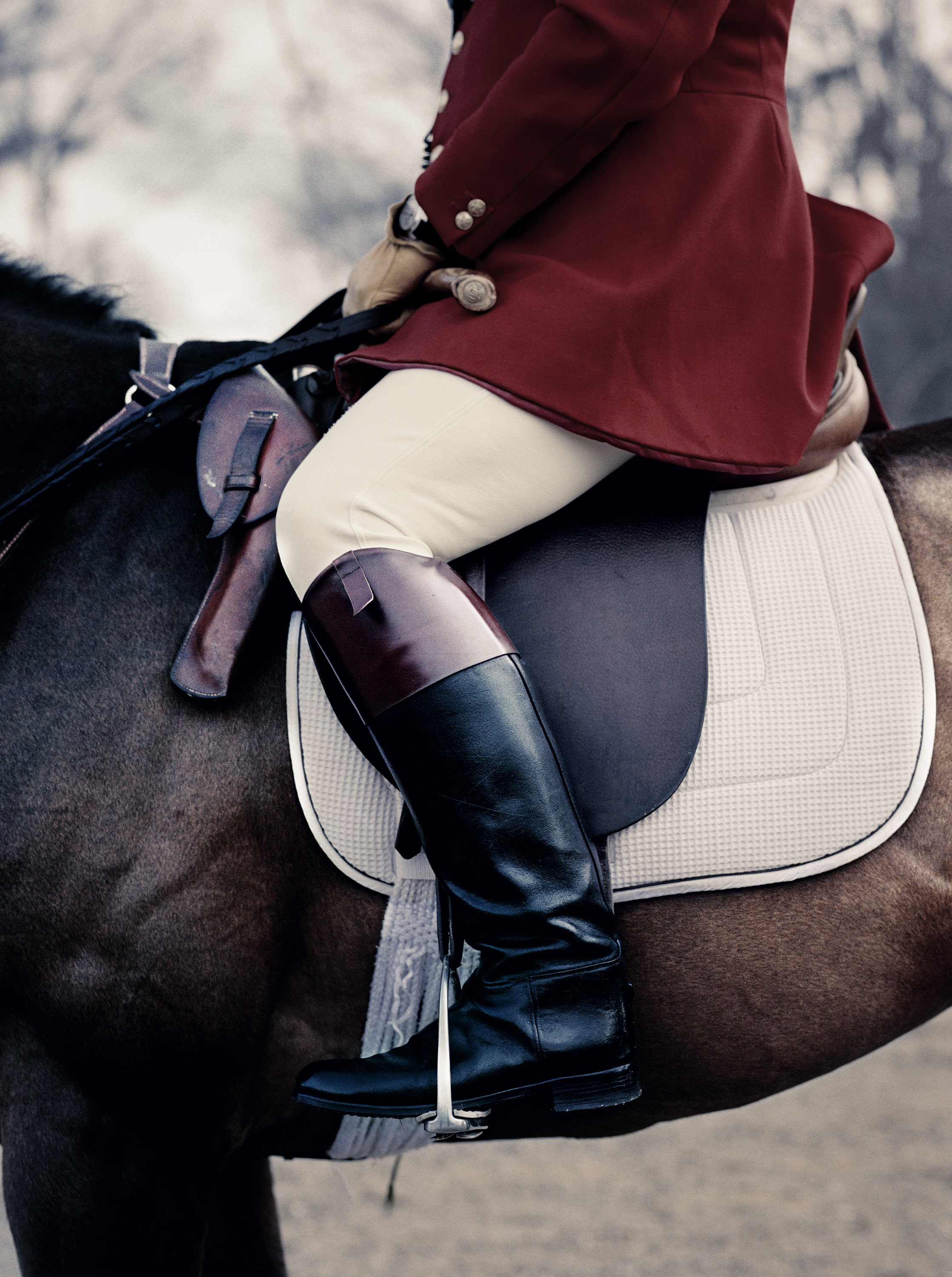
Photo: Andy Anderson
“The reason we get up in the morning is you never know,” he says. “The tenth time you run, you have a day you always remember.”
And that’s when it hits me. I understand exactly why Hardaway is up before everyone, hunt after hunt, and why so many others join him in fair and foul weather to hunt the rarely seen fox. It’s the not knowing.
Once again, Hardaway and I set out in the White Stallion. Downed trees from a recent tornado litter the track as we drive the narrow lanes the hunt staff has carved through the snarl of hardwoods. Suddenly, the dogs strike a scent in an open field and go tearing through the woods. There’s a clamor of howls and urgent cries as the others join the chase. One hound’s whooping bark rises above the rest, ululating with feral joy. Their high, haunting notes drift through the branches, and my heart starts to sprint along with them. Now I know what young Ben Hardaway felt when he first heard their strange cry. The longtime master of foxhounds rattles off directions via radio as our Jeep maneuvers through the tangled brush for us to catch sight of the dogs. We finally do, and it is a good run, the best of the day. Though we still don’t catch a fox, I’m starting to think that it’s beside the point. We’re out in the fresh air on a beautiful blue-sky winter day, with a few more good chases ahead of us, and despite the low-scenting conditions, one of them could always be a hunt to remember. Hardaway proudly points out a couple young hounds with talent, and I have to ask if he’s excited about the next season.
“Hell, I’m just hoping to be here. But I ain’t buying no green bananas.”
So we charge on into the brush.







